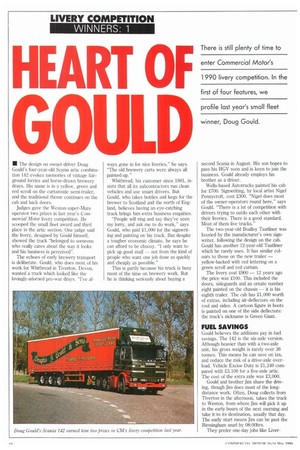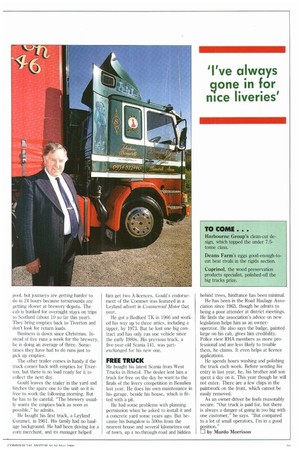HEART OF
Page 72

Page 73

If you've noticed an error in this article please click here to report it so we can fix it.
GO
• The design on owner-driver Doug Gould's four-year-old Scania artic combination 142 evokes memories of vintage fairground lorries and horse-drawn brewery drays. His name is in a yellow, green and red scroll on the curtainside semi-trailer, and the traditional theme continues on the cab and back doors.
Judges gave the Weston-super-Mare operator two prizes in last year's Commercial Motor livery competition. He scooped the small fleet award and third place in the artic section. One judge said the livery, designed by Gould himself, showed the truck "belonged to someone who really cares about the way it looks and his business is perceived".
The echoes of early brewery transport is deliberate. Gould, who does most of his work for Whitbread in Tiverton, Devon, wanted a truck which looked like the lovingly-adorned pre-war drays. "I've al ways gone in for nice liveries," he says. The old brewery carts were always all painted-up."
Whitbread, his customer since 1981, insists that all its subcontractors run clean vehicles and use smart drivers. But Gould, who takes bottles and kegs for the brewer to Scotland and the north of England, believes having an eye-catching truck brings him extra business enquiries.
"People will ring and say they've seen my lorry, and ask me to do work," says Gould, who paid 21,000 for the signwriting and painting on his truck. But despite a tougher economic climate, he says he can afford to be choosy. "I only want to pick up good stuff — not from the kind of people who want one job done as quickly and cheaply as possible."
This is partly because his truck is busy most of the time on brewery work, But he is thinking seriously about buying a second Scania in August. His son hopes to pass his fIGV soon and is keen to join the business. Gould already employs his brother as a driver.
Wells-based Autotrucks painted his cab for 2700. Signwriting, by local artist Nigel Pennycroft, cost 2300. "Nigel does most of the owner-operators round here," says Gould. "There is a lot of competition with drivers trying to outdo each other with their liveries. There is a good standard. Most of them live trucks."
The two-year-old Boalloy Tautliner was liveried by the manufacturer's own signwriter, following the design on the cab. Gould has another 12-year-old Tautliner which he rarely uses. It has similar colours to those on the new trailer — yellow-backed with red lettering on a green scroll and red curtain.
The livery cost 2900 — 12 years ago the price was 2100. This included the doors, sideguards and an ornate number eight painted on the chassis — it is his eighth trailer. The cab has 21,000 worth of extras, including air-deflectors on the roof and sides. A cartoon figure in boots is painted on one of the side deflectors: the truck's nickname is Green Giant.
Gould believes the additions pay in fuel savings. The 142 is the six-axle version. Although heavier than with a two-axle unit, his gross weight is rarely over 36 tonnes. This means he can save on tax, and reduce the risk of a drive-axle overload. Vehicle Excise Duty is 21,240 compared with 23,100 for a five-axle artic. The cost of the extra axle was 23,000.
Gould and brother Jim share the driving, though Jim does most of the longdistance work. Often, Doug collects from Tiverton in the afternoon, takes the truck to Weston, from where Jim will pick it up in the early hours of the next morning and take it to its destination, usually that day. The early start means Jim can be past the Birmingham snarl by 08:00hrs.
They prefer one-day jobs like Liver pool, but journeys are getting harder to do in 24 hours because turnarounds are getting slower at brewery depots. The cab is bunked for overnight stays on trips to Scotland (about 10 so far this year). They bring empties back to Tiverton and don't look for return loads.
Business is down since Christmas. Instead of five runs a week for the brewery, he is doing an average of three. Sometimes they have had to do runs just to pick up empties.
The other trailer comes in handy if the truck comes back with empties for Tiverton, but there is no load ready for it to collect the next day.
Gould leaves the trailer in the yard and hitches the spare one to the unit so it is free to work the following morning. But he has to be careful. "The brewery usually wants the empties back as soon as possible," he admits.
He bought his first truck, a Leyland Commet, in 1961. His family had no haulage background. He had been driving for a corn merchant, and its manager helped
him get two A-licences. Gould's endorsement of the Commet was featured in a Leyland advert in Commercial Motor that year.
He got a Bedford T1( in 1966 and worked his way up to three artics, including a tipper, by 1973. But he lost one big contract and has only run one vehicle since the early 1980s. His previous truck, a five-year-old Scania 141, was partexchanged for his new one.
He bought his latest Scania from West Trucks in Bristol. The dealer lent him a truck for free on the day he want to the finals of the livery competition in Beaulieu last year. He does his own maintenance in his garage, beside his house, which is fitted with a pit.
He had some problems with planning permission when he asked to install it and a concrete yard some years ago. But because his bungalow is 500m from the nearest house and several kilometres out of town, up a no-through-road and hidden behind trees, hindrance has been minimal.
He has been in the Road Haulage Association since 1963, though he admits to being a poor attender at district meetings. Ile finds the association's advice on new legislation helps him as an owneroperator. He also says the badge, painted large on his cab, gives him credibility. Police view RHA members as more professional and are less likely to trouble them, he claims. It even helps at licence applications.
He spends hours washing and polishing the truck each week. Before sending his entry in last year, he, his brother and son spent a day on it. This year though he will not enter. There are a few chips in the paintwork on the front, which cannot be easily removed.
As an owner-driver he feels reasonably secure. our truck is paid for, but there is always a danger of going in too big with one customer," he says. "But compared to a lot of small operators, I'm in a good
























































































































